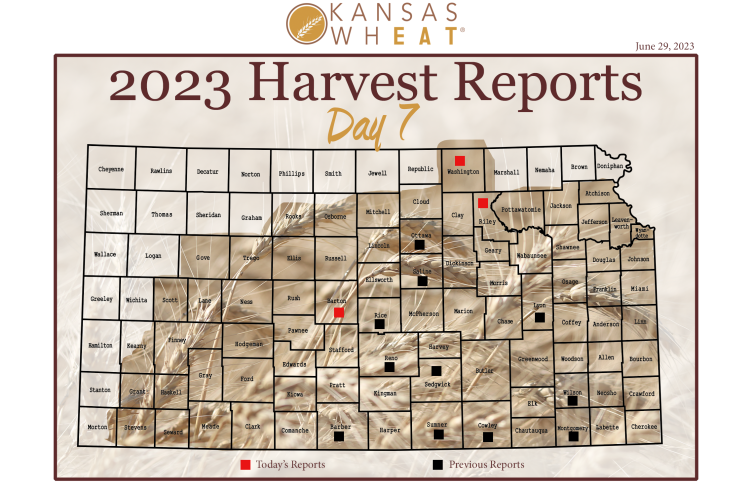Breadcrumb
- Home
- Day 7, Kansas Wheat Harvest Report
This is day 7 of the Kansas Wheat Harvest Reports, brought to you by the Kansas Wheat Commission, Kansas Association of Wheat Growers, Kansas Grain and Feed Association and the Kansas Cooperative Council.
Triple-digit temperatures mean it certainly feels like the right weather to harvest wheat, but producers and elevators alike are feeling behind schedule. Wheat harvest has shifted west, moving into areas with more extreme drought conditions and more abandoned acres. The wheat acres that remain are coming in below average, but slightly better than expected, while producers adjust their harvesting to address pressure from late-growing weeds.
At the Nebraska border, Neil Bekemeyer started harvest on Monday, June 26, and expects to finish up in the next few days. In Washington County and up into Nebraska, Bekemeyer had hail on Wednesday night, which did not break the hollow wheat stems, but did have a bit of shatter. Wheat fared better than corn, much of which was blown over in the wind.
Bekemeyer was surprised at the yields he was seeing, especially considering the moderate amount of weeds below the canopy. Outstanding varieties included AgriPro Bigfoot and LCS Valiant - with test weights coming in between 58 and 60 pounds per bushel.
In Riley County, Kansas Wheat Commission board member, Nathan Larson has mixed feelings about this year’s wheat crop. He recalled how difficult it was to get his crop in last fall because there was too much moisture to even get into fields. He still thinks there was moisture in the ground to help the wheat grow, but his stands did not fill out with tillers like he had hoped, and he had more weed pressure.
Larson has been delivering Syngenta Monument crop to the local elevator in Leonardville, where test weights have not been great at an average of 58 pounds per bushel. Overall, his crop is averaging 30 bushels per acre.
“It’s a disappointing year, but when you think about southwest Kansas, it’s not a BAD year,” Larson shared.
Back in central Kansas, Del Adcock of Bartlett Grain in Great Bend reported the area is about 10 days to two weeks behind normal. So far, they’ve taken in about 20 percent of the wheat they expect to receive. Test weights are good, averaging 60 pounds per bushel and above, with higher-than-average protein.
Adcock said yields are averaging in the high 20s to low 30s with a range from the teens to 50 bushels per acre. Weeds are everywhere, due to thin stands and the crop maturing later than normal.
Bartlett Grain has a six-county draw radius and Adcock expects to receive about half the wheat of an average year. Sitting on a short line rail line, the facility will send wheat to their core business in Mexico as well as company-owned flour mills in Coffeyville, Kansas, and North Carolina.
There’s little excitement about this year’s crop, as approximately 40 percent of acres were abandoned and yields on the remaining wheat are much lower than average.
“Everybody’s ready to have harvest done and out of the way,” Adcock said.
In the northern part of Barton County, Dean Stoskopf reported even higher abandonment, estimating up to 90 percent of local acres would not be harvested due to extreme drought conditions. Some of Stoskopf’s fields went a year without an inch (or some even a half inch) of moisture. The majority of the county finally moved out of D4 (exceptional) drought, thanks to rains in the past two weeks, but more rain is needed to keep that status at bay.
“If it doesn't rain, we’ll be right back in exceptional drought,” Stoskopf said.
Stoskopf abandoned 80 percent of planted acres and chose not to spray the remaining 200 acres. As a result, he decided to use only a conventional combine, which handles the ever-growing weeds better than his other rotary head. He noted 100-degree weather also helps chop weeds a little bit easier.
Stoskopf cut his first field on Wednesday with final results coming in just above crop insurance estimates at 23 bushels per acre, acceptable 12 percent moisture, excellent test weight at 60 pounds per bushel and good protein at 12.8 percent. The only surviving variety on his operation is PlainsGold Whistler, which benefitted from last-minute moisture as a late-maturing variety.
“What survived isn’t doing too bad, but there aren’t many acres of it,” Stoskopf said. “There just is not a whole lot of wheat coming in.”
Summertime temperatures will continue to advance the pace of wheat harvest in the coming days ahead of the July 4th holiday and a cold front next week. Stay tuned as the Kansas Wheat crew continues to share results from the field with the next report scheduled for July 5.
The 2023 Harvest Report is brought to you by the Kansas Wheat Commission, Kansas Association of Wheat Growers, Kansas Grain and Feed Association and the Kansas Cooperative Council. To follow along with harvest updates on Twitter, use #wheatharvest23. Tag us at @kansaswheat on Facebook, Instagram and Twitter to share your harvest story and photos.
###
Written by Julia Debes for Kansas Wheat

